Traditional Mexican cooking includes grilling, frying and steaming over an open fire or stove. Corn or maize, in all its variations, was the main food source along with beans, avocados, chili peppers, and Nopal cactus. Spices and herbs were also important additions to their traditional dishes.
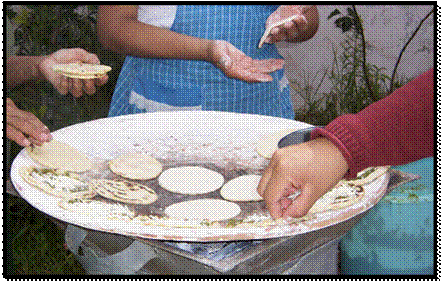
Terra Cotta Comal
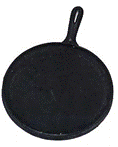
Cast Iron Comal
~A comal is a smooth, flat griddle used to cook tortillas as well as other foods. In early times, the comal was used over an open fire. The word comal has its origins in the Aztec language. The Comals were originally made of clay; today, they are also available in cast iron and are made to fit easily over burners on a stove. Notice that the terra cotta comal is concave in design.
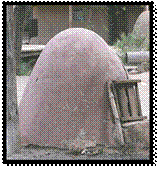
Traditional horno
~A horno is a mud adobe oven built outdoors and usually placed under a ramada for shade. Traditionally, it has a beehive shape and burning wood is used as its source of heat. Horno is the Spanish word for oven or furnace; it was introduced to New World inhabitants by the conquistadores. In order to bake bread, wood fires are burned to heat the adobe oven and then the embers and ashes are removed and the bread is placed into the horno to bake. For steaming corn, the embers are doused with water to make steam prior to placing the corn in the oven. Meats are also cooked in the oven, but the embers are pushed to the back of the oven, rather than removed.
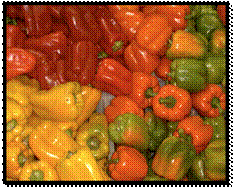
~Chili peppers are native to the Americas, but different varieties are found all over the world today. Basically there are three types of chili peppers: bell peppers, sweet peppers and hot peppers. The spelling of chilies varies and all spellings are correct. Possible variations include: chili, chile, or chilli. Chili peppers (dried, fresh, or powdered) are used extensively in Mexican dishes.

metate y mano
One of Esperanza’s cooking chores was to help grind lime-soaked corn or maize into masa or corn dough for tortillas. To complete this task, she used a grinding stone or metate with a hand-held stone called a mano.
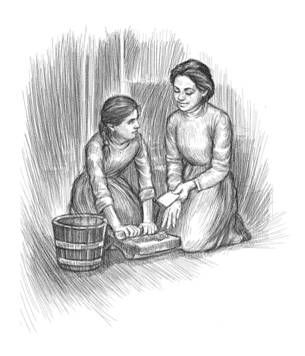
Although she thought it was hard work, Esperanza had successfully mastered the grinding of the maize into masa, but she had a difficult time with shaping the tortillas into circles and cooking them evenly. Re-read page 13 to refresh your memory about her “burnt tortillas” and the taunting she endured from her cousin, María Elena, about her misshapen tortillas.
On page 99, the process of tortilla making is described:
Esperanza had to make corn tortillas for dinner. Not her favorite job. She went into the kitchen and got the bucket of corn kernels soaking in lime water. Carefully, she carried it to the porch, setting it next to the large grinding stone called a metate. Scooping the corn out of the pot with a slotted spoon, she dropped it onto the metate, then pounded it into dough with a mano, a grinding stone that fit into her hand. Whew, it was hard work. When she had ground enough masa for dinner, she pinched a small ball, and rapidly patted it into a tortilla. The first try resembled a triangle more than the perfect round shapes that Mamá and María Elena made. Esperanza sighed, put the tortilla in a basket, and went onto the next week.
Note: You will need two days preparation for tortillas made from dried kernels because they need to be soaked in water for twenty-four hours before cleaning and grinding.
Ingredients:
Directions:
Note: If you have a specialty Mexican market nearby, you can purchase the masa dough freshly made and ready to press or roll out into tortillas.
Using Masa Mix to Make the Corn Dough
Most supermarkets carry masa in a specialty aisle of the store. Ask a store clerk where you can find this product.
Ingredients:
Directions:
Rolling or Pressing the Corn Dough into Tortillas
Using a rolling pin to make the tortillas: ![]()
Using a tortilla press to make the tortillas
Cooking the tortillas:
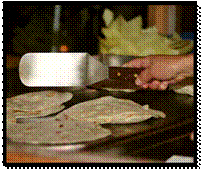
 and Posole
and PosoleTwo dishes eaten by Esperanza and her family are more complicated to make. Consider ordering these from an authentic Mexican restaurant in order to taste these wonderful, traditional soups and stews.

rope of chili peppers or ristras

Nopales are a vegetable made from the young pads (leaves) of the prickly pear cactus or opuntia, which is native to Mexico and other places around the world. In Mexico, the plant is eaten commonly and is an ingredient in many Mexican dishes. Click for more information on Nopales. The green or purple pads are flat, hand-sized and are the most juicy and tender in the spring. They have a similar taste as green beans. The spines on the pads need to be carefully removed in order to prepare and cook the pads. Today nopales can be purchased fresh, canned or even dried in many supermarkets on the specialty aisle.
Scrambled Nopales or Nopales con Huevos
Ingredients:
Directions:
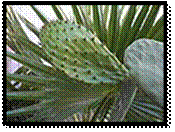
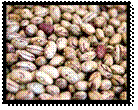 Frijoles Refritos
Frijoles RefritosPinto beans are a staple of Mexican cuisine.
Cooking the Pinto Beans
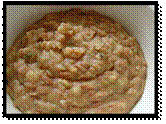
Refried Beans (Frijoles Refritos)
Refried beans are actually only fried once; the word refritos means “very well fried.”
Ingredients:
Optional:
Directions:

On page 99 in Esperanza Means Hope, Mamá packed Papá and Tío Francisco some food in cotton bags. She included cornmeal and brown sugar to make pinole. Pinole is coarse flour made from ground toasted corn kernels and sometimes mixed with a variety of ground seeds or herbs. It can be made into a drink, a mush-like food or corn bread.
Hot Pinole Drink #1
Ingredients:
Directions:
Hot Pinole Drink #2
Ingredients:
Directions:
Pinole Corn Bread
Ingredients:
Directions:
Native Seeds – SEARCH Recipe for Pinole Cornbread:
Click to view recipe

8 – 10 feet tall during the months of May or in early June; the fruit matures in July and August at which time it can be harvested.
6 cups saguaro cactus pulp ![]() Water
Water
Gather saguaro cactus fruit. Put 6 cups of the pulp in a pot and add water until half of the pulp is covered. Soak the pulp for 1 1/2 hours. Stir every now and then. Put the pot over low heat and cook for 30 to 40 minutes.
Separate the pulp from the liquid, saving the pulp. Boil the liquid very slowly, stirring constantly, until it turns into syrup. Then mash the pulp and put through a strainer to remove the seeds. Combine the remaining pulp with the syrup until the mixture is the consistency of jam. When it looks like jam, it is jam.
DO NOT ADD SUGAR.
In Chapter Thirteen of Esperanza Means Hope, Esperanza and Carlos collected a basket full of the saguaro fruit using a long cross-topped pole to detach the fruit and burlap bags to catch the fruit; jam is one of Carlos’ favorite treats and Esperanza’s mother planned to make some for him and the rest of the family.
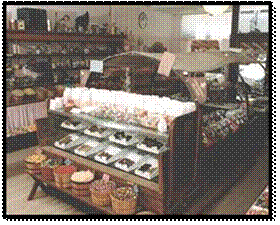
A typical “penny” candy display in the old days
In Chapter Three, when Pinto found an American silver dollar in Gallego’s corral, he excitedly declared, “I’m going to buy a heap of candy at Lord and Williams store today. I’m going to make it last all year and I’m not sharing with any of my brothers, either…”
The candy or confectioner’s industry developed rapidly in the beginning of the 19th century and by the mid-1800s there was a “penny” candy craze going on in the country. There were 380 candy manufacturers in the nation making all sorts of hard candies and experimenting with flavors and new innovations in size, colors and even shapes. The “chocolate” candy rage had not yet taken over.
Homemade hard candies, such as lemon drops and peppermint sticks, became easily accessible. General stores began to sell hard candies by weight from an array of colorful glass jars. They would then package the selected candies in small paper bags to take home. These were known as “penny” candies.
The ingredients for hard candy are basically: sugar, corn syrup, water, food coloring and flavorings. The sugar mixture is brought to a boil…and yummy, sweet candy is the result.
Temperatures matter in making candy. Candies are categorized by their hardness, and hardness is dependent on the temperature to which the sugar is heated. Sugar cooked at a low temperature results in chewy candy; medium heating results in a soft candy; and sugar cooked at a high temperature becomes hard candy.
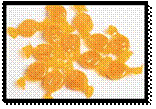
Ingredients:
Directions:

 The various species of yucca plants were important to many native Southwest tribes. Many used the sharp-pointed, waxy leaves for weaving. The Apaches used the long flower stalks and creamy white blossoms as a source of food. Most importantly, the roots of the yucca provided many Native Americans with a great natural shampoo and laundry soap because of its lathering properties.
The various species of yucca plants were important to many native Southwest tribes. Many used the sharp-pointed, waxy leaves for weaving. The Apaches used the long flower stalks and creamy white blossoms as a source of food. Most importantly, the roots of the yucca provided many Native Americans with a great natural shampoo and laundry soap because of its lathering properties.
In Chapter Six of Esperanza Means Hope, Esperanza’s father punished her by making her help Rosa, a hired Papago Indian woman, wash the family’s laundry at the acequia madre (the main irrigation ditch). At the ditch, they wet the clothes, applied soap, pounded them against the rocks and then hung them on the surrounding bushes to dry. Esperanza brought homemade lard soap to wash her clothes, while Rosa brought yucca root soap. Rosa remarked that yucca root soap was much easier on the clothes; Esperanza disagreed.
Follow the directions below to make your own yucca root soap, similar to the soap that Rosa would have made and used in the 1870s. You will need to make this soap with the assistance of an adult!
The Blue Willow Pattern Legendby Mary L. Stollard
Nearly every home in our country contains a specimen of some kind of the famous willow pattern ware. Yet even today, many people have never heard the true story of the willow pattern. For nearly two centuries, it has been one of the most popular of china designs, and many children have gazed entranced at the quaint little figures of the familiar willow pattern jingle – ‘Two birds flying high,
A Chinese vessel, sailing by. A bridge with three men, sometimes four, A willow tree, hanging o’er. A Chinese temple, there it stands, Built upon the river sands. An apple tree, with apples on, A crooked fence to end my song.’ It tells of Knoon-shee, a lovely Chinese maiden, whose affections were bestowed upon her father’s secretary, Chang, but who was commanded by her parents to wed a wealthy rival suitor. She refused to comply with their wishes, whereupon her enraged father locked her up in the little house just visible on the left of the temple. From here she contrived to send a message to her lover, ‘Gather thy blossom, ere it be stolen.’ Thus encouraged, Chang succeeded in entering the apple orchard and carrying off his beloved. So we see them hurrying over the bridge. Knoon-shee with a distaff, and Chang carrying her box of jewels, while the angry father follows hard after them armed with a whip. The couple made good their escape in the ‘Chinese ship sailing by’ and landed on the island, which can be seen on the left of the picture, where they took refuge in the little wooden house. But the father and discarded suitor tracked them and set fire to the house while they were sleeping; and so the lovers perished. Next morning, from the ashes rose their spirits, in the forms of two doves. And so we see them with out-stretched wings flying off to the realms of eternal happiness.
No one knows the origin of this story. It was told in China more than a thousand years ago and brought over to our country from Eastern lands by the Crusaders. The willow pattern, as we know it today, was designed by one Thomas Minton about 1780, and bought from him by Thomas Turner, a famous potter and manager of Shropshire pottery. At that time the craze for collecting souvenirs from the East was at its height and this dainty little design, so typical of Chinese people, instantly became popular. Other potters copied the pattern with some variations, and though at first sight all willow patterns look alike, the different makes can be distinguished by various small details, such as the number of apples, the figures on the bridge, and the design of the crooked fence. All early potters, however, used the same shade of cobalt blue, and though we have since had many other shades of lighter and darker tones, even browns or blacks, the original cobalt blue has always remained first favorite. Few other makes of china are more attractive then a really good specimen of willow pattern, with their exquisite markings and minute detail carefully and accurately copied. |
| Appetizer: (optional) |
| Main Course: (select one) ~With an adult, select one of the center recipes and make a traditional Mexican-American dish, yucca root soap or hard candy. Share your cooking and eating experiences during a show-and-tell at school. ~Read through the information that accompanies the various cooking recipes in the center. Then take the quiz on Mexican-American cooking and cuisine. (In this option, you do not prepare any of the recipes.) ~Design your own Mexican-American meal menu. Include your favorite Mexican-American dishes; add enticing pictures. Display in your classroom. ~Research traditional Apache foods and compare them to the Mexican-American cuisine on an 8 X 11 sized poster. Can you find a recipe for kneel down bread? ~Make a string of chili peppers or ristras to hang and dry out in your house. Find directions on how to make chili powder out of dried peppers. Post for classmates to view. |
| Side Dishes: (select two) ~The prickly pear cactus also bears a fruit (pear) that can be used to make a variety of jellies, jams and drinks. Locate a prickly pear cactus recipe and post it on your classroom website. ~Turn to page 34 in Esperanza Means Hope. Read the list of delicacies served at the Ochoa’s party. Make a drawing of the table with the various foods spread out on a white tablecloth. Don’t forget to draw the jellied pigs’ feet! ~When Lt. McKinney and Sgt. Polk stay for dinner at Esperanza’s house, she sets the table with the good china – the Blue Willow plates. Read the “Blue Willow Pattern Legend” from the center or read the book, Blue Willow by Pamela Conrad. Then draw a circle “china plate” pattern to illustrate any part of the story of Esperanza and her family. You can only use a blue colored pencil, blue marker or blue paint to illustrate their story. ~Click to watch the YouTube videos made by students about the legend of the Blue Willow plate. The Story of the Willow Plate and click to watch the Willow Pattern Story. Make your own digital or animated story of any part of Esperanza and her family’s story using a blue pattern model. ~Research chili peppers and find out the following information: its history, culinary uses, varieties, heat intensity and nutritional value. Make a chili pepper shaped booklet with your information inside to share with classmates. ~Make a labeled display of different chili peppers (real or pictures) and gather information from classmates about their experiences with “hot” jalapeños peppers or chili pepper products. |
| Dessert (optional) ~Research the types of candy that Lord and Williams Store in Tucson, 1876 probably sold as penny candy. Make a list of 10 different candies that Pinto could have chosen to buy. Make butterscotch candy your #1 candy. Find 9 more candies to complete your list.
|
True or False: Place a T or F in front of each statement. If the statement is false, make it correct by changing the information.
Fill-in-the Blank
Short Answer
Retell the story of the Blue Willow plate in your own words.
True or False: Place a T or F in front of each statement. If the statement is false, make it correct by changing the information.
Fill-in-the Blank
Short Answer
Answers will vary. Self-check your story facts and the sequence of your details.